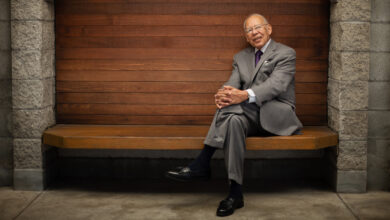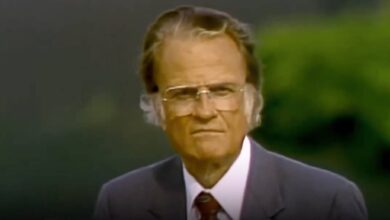Why the American Church Can’t Fix Loneliness

This piece was adapted from Russell Moore’s newsletter. Subscribe here.
I don’t know how to say, ‘I’m lonely,’ without sounding like I’m saying, ‘I’m a loser,’” a middle-aged man said to me not long ago. “And I don’t know how to say it without sounding like I’m an ungrateful Christian.”
After all, this man said, he’s at church every week—not just there, but active. His life is a blur of activities. But he feels alone. In that, at least, he’s not alone.
Repeatedly, almost all of the data show us the same thing: that the so-called “loneliness epidemic” experts warned about is real. We all know it’s bad, and we sometimes have a vague sense of why it’s happening. The answers that some come up with are often too big to actually affect any individual person’s life. Smartphones aren’t going away. We aren’t all moving back to our hometowns. We see a kind of resigned powerlessness to change society’s lonely condition. So why can’t the church fix this?
The answer lies partly in a book published a near quarter-century ago: political scientist Robert Putnam’s famous Bowling Alone: The Collapse and Revival of American Community. Earlier this summer, The New York Times interviewed Putnam, asking him whether, since he saw the loneliness crisis coming, he saw any hope of it ending.
Putnam reiterated that the answer is what he calls “social capital,” those networks of relationships needed to keep people together. Social capital comes in two forms, Putnam insists, and both are necessary. Bonding social capital is made up of the ties that link people to other people like themselves. Bridging social capital consists of the ties that link people to those unlike themselves.
The first time I was on set with a television talk-show host who, like me, grew up Southern Baptist, he turned to me before we went on the air and said, “Pop quiz: What should always be the first song in a hymnal?” I immediately responded with the right answer (“Holy, Holy, Holy”), and we high-fived. No one else on that set knew what we were talking about. The secularist in the producer’s chair might have thought, “What’s ‘Holy, Holy, Holy’?” The churchgoing evangelical behind the camera might well have thought, “What’s a hymnal?”
That little detail of shared tribal memory, though, represented more than trivia. It was a way of recognizing one another—the same sort of church background, from the same sort of time period, the same sort of shared experience. We knew in that moment that, even if no one else in New York City knew the names of Lottie Moon and Annie Armstrong, we did, and, even if no one in that television network building could say what words would follow “I pledge allegiance to the Christian flag,” we would. All of us experience equivalent moments of bonding social capital.
Putnam makes it clear that one form of social capital is not “good” and the other “bad.” When you’re sick and need to be taken care of, usually that comes from relationships made with bonding capital. That’s good, but—when taken too far—really dangerous. Putnam notes that the Ku Klux Klan is “pure social capital” of the bonding sort. Bridging capital, Putnam argues, is much harder, but both are needed for a person or a society to escape isolation.
We know the statistics on religious decline in the United States, especially when it comes to actual weekly church attendance. Some (though not all) of that decline is driven by the same factors that wiped away bowling leagues and Lions Clubs and neighborhood watch programs.
But maybe we ought to flip the question around. We live in a country with churches everywhere, and the vast majority of people—at least for a long time in the 20th century—belonged or currently belong to some sort of church. So why weren’t the factors that eroded social capital not arrested long before we arrived at this point?
One factor is what Putnam’s getting at with the necessity of bridging and bonding. The Bible holds both sorts of social capital together.
In the Old Testament, Israel is distinct from the nations, with the highest bonding capital imaginable employed to keep them together. At the same time, they were reminded constantly that they were to be a “light to the nations,” bridging the divides that had sundered humanity since Babel.
In the New Testament, the pioneer church was to be bonded—serving each other at the Lord’s Table, equipping each other with spiritual gifts, uniting voices together in worship. That’s why the imagery of the family is applied constantly in the epistles to the church. Simultaneously, the Great Commission—to disciple all nations—requires bridging capital, often of the sort we see Paul employ at Mars Hill in Athens or with Gentile audiences of all sorts.
In fact, the bonding of people who were bridged to one another is one of the primary themes of book after book of the New Testament (Acts, Romans, Galatians, etc.).
A church that is evangelistic (seeking to share Christ with one’s neighbors and with the nations of the world) relies on bridging social capital. A church that considers its members as brothers and sisters, as one body with many members, counts on bonding social capital.
What we have long seen in the American church—almost without reference to theological distinctives or denominational identity—is a severing of bridging social capital from bonding social capital.
Many of the more “missional” congregations—especially the larger ones—did bridging social capital very well. They taught married couples how to relate to single young adults, how to talk to the Buddhist down the street, how to anticipate the way a secularist might think about why a good God would let bad things happen to good people, and so on. But many of these churches now admit they did so without a lot of bonding social capital. The people didn’t know each other. They weren’t deeply discipled.
On the other hand, lots of other churches did bonding without bridging. Some of these churches were ingrown, of the sort we’ve all seen, where two or three families are the inner circle and no one else can ever really belong. Some of them thought themselves to be “evangelistic,” but without teaching their people any real bridging social capital: a church of white, college-educated, suburban young professionals with children, for instance, devoted to reaching white, college-educated, suburban young professionals with children.
Once the bridging and bonding forms of social capital are broken, then, something must take their place. What that’s turned out to be is imaginary social capital. A number of people turn to imaginary bridging capital. Some who’ve fled what they considered the smothering conformity of the church think they are now bridging people unlike themselves, but just end up with other people who’ve fled what they considered to be the smothering conformity of the church. That’s imaginary bridging capital—not the real thing.
And some people turn to the imaginary bonding capital of Christian nationalism or ethnic Kinism. Why is almost every neo-Confederate I know a Yankee from Minnesota or Ohio or Idaho? It’s because it’s a way to pretend to have bonds with “one’s own kind.” But hating the same people does not a community make. What’s the end result? More loneliness, and then resentment at the being lonely, and the finding someone to blame for being lonely. As Dwight Schrute from The Office once put it, “They say that no man is an island. False! I am an island, and this island is volcanic.”
All around us, we see archipelagoes of lonely islands, with volcanoes spewing hot, molten lava on many of them.
In his interview with the Times, Putnam makes a point that too many of us miss. We need something like bowling leagues to save democracy, he said, but it doesn’t work if people are joining the bowling leagues to save democracy. They have to bowl because it’s fun. Along the way, communities get healthier, but that’s a byproduct.
Churches combat loneliness not by telling people, “Come to church so you won’t be lonely; it’s good for you.” People should come to church because it’s true—Jesus is alive and seated at the right hand of the Father, forgiving our sins and coming again. Those of us convinced of this should then remind ourselves that we belong to one another, that we are not our own. We should remind ourselves that the great congregation in heaven is made up of every tribe, language, people, and nation (Rev. 5:9).
On mission together to bridge the outside world to the God who loves them, we bond along the way. In fellowship to bond as a family whose commonality is Christ, we stir ourselves up to love the people he loves, so we become bridges along the way.
Social capital is not the most important thing. The kingdom of God is (Matt. 6:33). But the brokenness of social capital—inside and outside the church—might prompt us to retrace our steps. We might see some burned bridges, some broken bonds—all of which Jesus knows how to piece back together again.
Russell Moore is the editor in chief at Christianity Today and leads its Public Theology Project.




